Flat Panel Antenna Market Research, 2032
The global flat panel antenna market was valued at $435.9 million in 2021, and is projected to reach $5.1 billion by 2031, growing at a CAGR of 28.1% from 2022 to 2031.
A flat panel antenna, which only sends and receives radio signals in one direction, is one sort of directional antenna. Its wider beam enables the signal to disperse across a larger area. Flat-panel antennas are now being developed for maritime satellite communications applications in addition to being used for military, naval, and commercial aircraft radar.
Defense, military, and corporate aircraft radar all use flat panel antennas that employ phased array technologies, and more recently, television broadcasting. A number of engineering types are competing, with "phase shifter" presently being the most viable, to make flat panel antennas a more viable alternative in the maritime sector.
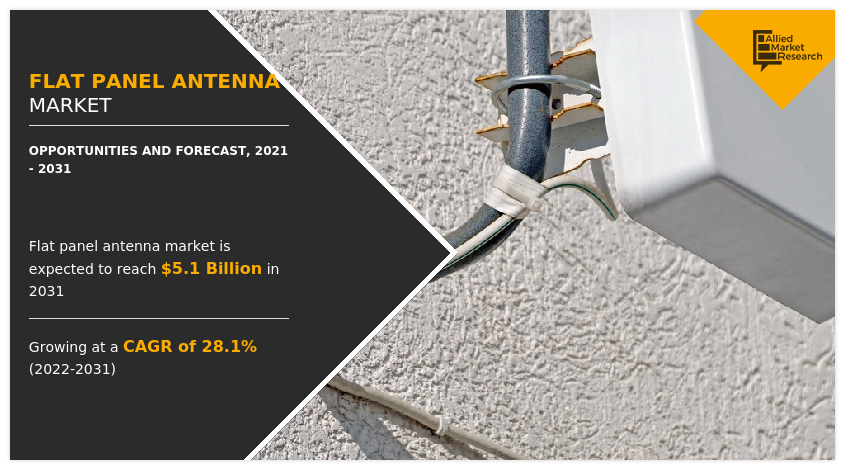
The need for flat panel antennas has increased as people's knowledge of technological developments in satellite and space research has increased. This market's expansion is being driven by the use of ultra-thin flat panel antenna in different applications.
Segment Overview
The flat panel antenna market is segmented into Type, Operating Frequency, End-Use Vertical, and Region
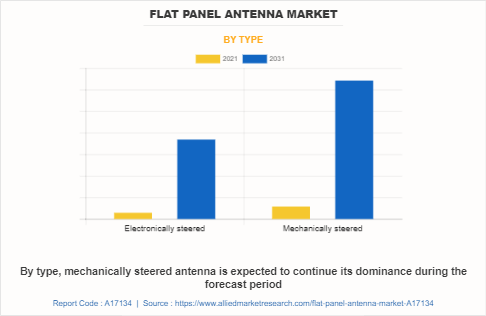
An electronically steered antenna (ESA) is a type of computer-controlled phased array antenna that is primarily used in radar systems and allows the radio wave beam to be electronically steered in various directions without physically moving the antenna. It is suitable for military and telecommunication end-use applicants.
A series of internal plates with precise resonance characteristics are mechanically rotated in mechanically steered flat panel antennas to amplify and direct the signal in a particular direction. While internal discs in this flat panel antenna are mechanically moved, unlike a gimbal antenna, the entire antenna face is not directly pointed at the satellite internal plates.
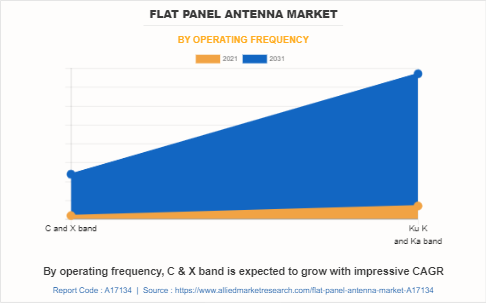
C band is used for satellite communications, for full-time satellite TV networks or raw satellite feeds. X-band radar frequency sub-bands are used in civil, military and government institutions for weather monitoring, air traffic control, maritime vessel traffic control, defense tracking, and vehicle speed detection for law enforcement.
The Ku, K and Ka band frequency spectrum (18-40GHz) for satellite communication is the basis for a new generation of services on High Throughput Satellites (HTS), which use a spot beam configuration to deliver more bandwidth throughout the coverage area. Ku, K and Ka band provides wide beam coverage as compared to other bands.
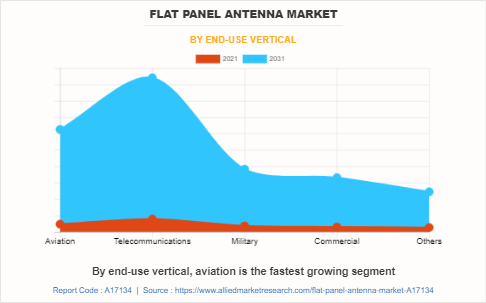
Military, naval, and commercial aviation radar all use flat panel antennas that employ phased array technology, and more recently, satellite television. Several technology types are competing, with "phased array" currently being the most competitive, to make flat panel antennas a more viable option in the maritime and aviation market.
The commercial segment serves a variety of applications, including commercial shipping, superyachts, passenger cars, and other applications. As compared to the larger antennas that are typically installed on larger vessels for the purpose of broadband satellite communications, flat panel antennas are smaller, less expensive, and significantly more covert.
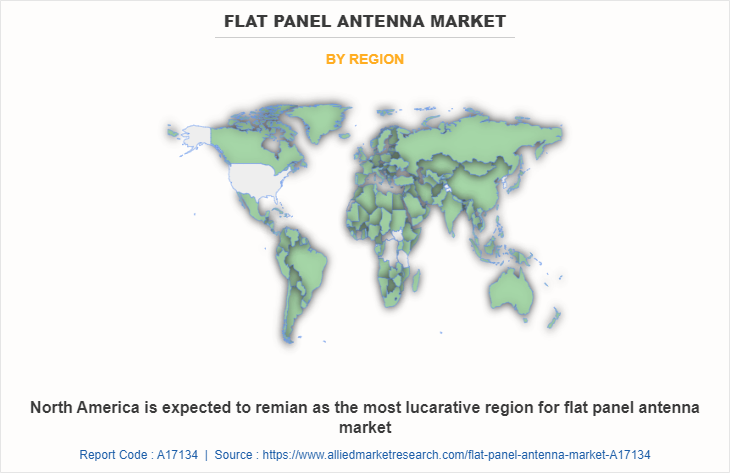
Region-wise, the Flat Panel Antenna market trends are analyzed across North America (the U.S. and Canada), Europe (Germany, Italy, France, Spain, U.K., Russia, and the rest of the Europe), Asia-Pacific (China, India, Japan, South Korea, and the rest of the Asia-Pacific), and LAMEA (Latin America, the Middle East, and Africa). North America, specifically the U.S., remains a significant participant in the global Flat Panel Antenna industry. Major organizations and government institutions in the country are intensely putting resources into the providing sophisticated flat panel antenna.
Top Impacting Factors
Growing public awareness of technological advancements in satellite and space exploration has fueled the demand for flat panel antennas. Also, application of ultra-thin flat panel antenna in numerous functions is propelling this market growth. The market may be hampered by a lack of experienced workers and costly development and maintenance expenses for the infrastructure necessary to support flat panel antennas. However, lucrative market opportunity is being created by the increasing usage of flat panel antennas in numerous end-use verticals.
Competition Analysis
Competitive analysis and profiles of the major flat panel antenna market players, such as ALCAN Systems GmbH, C-COM Satellites, China Starwin Science & Technology Co.,Ltd, Cobham Aerospace Communications, Gilat Satellite Networks, Hanwha Phasor (Hanwha Group), Isotropic Systems Limited, Kymeta Corporation, L3Harris Technologies, Inc., MTI Wireless Edge, NXT Communications, OneWeb, RadioWaves, SatPro Tech, ST Engineering, ThinKom Solutions and TTI Norte are provided in this report.
Key Benefits For Stakeholders
- This report provides a quantitative analysis of the flat panel antenna market size, current trends, estimations, and dynamics of the flat panel antenna market analysis from 2021 to 2031 to identify the prevailing Flat Panel Antenna Market Opportunity.
- The market research is offered along with information related to key drivers, restraints, and opportunities.
- Porter's five forces analysis highlights the potency of buyers and suppliers to enable stakeholders make profit-oriented business decisions and strengthen their supplier-buyer network.
- In-depth analysis of the flat panel antenna market segmentation assists to determine the prevailing market opportunities and flat panel antenna market outlook during the forecast period.
- Major countries in each region are mapped according to their revenue contribution to the global flat panel antenna market growth.
- Market player positioning facilitates benchmarking and provides a clear understanding of the present position of the market players along with their flat panel antenna market share at global as well as regional level.
- The report includes the analysis of the regional as well as Flat Panel Antenna Market Overview, key players, market segments, application areas, and market growth strategies as well as flat panel antenna market forecast.
- The report also provides brief overview of flat panel antenna market during the forecast period.
Flat Panel Antenna Market Report Highlights
| Aspects | Details |
| Market Size By 2031 | USD 5.1 billion |
| Growth Rate | CAGR of 28.1% |
| Forecast period | 2021 - 2031 |
| Report Pages | 262 |
| By Type |
|
| By Operating Frequency |
|
| By End-Use Vertical |
|
| By Region |
|
| Key Market Players | RadioWaves(Infinite Electronics International, Inc.), ALCAN Systems, Hanwha Phasor (HANWHA GROUP), TTI Norte, C-COM SATELLITE SYSTEMS INC, SatPro Tech, NXT Communications, Ball Corporation, L3Harris Technologies |
Analyst Review
As new products are introduced to the market or start to be implemented, demand for flat panel antennas is rising. With the continued increase in demand for Communication on the Move (COTM), flat panel antennas (FPA) are becoming more and more significant. While driving across the nation, even cars are connecting to the internet. There is some ambiguity regarding the competing technologies being employed to build the new items due to the rapid rate of development. One type of directional antenna is a flat panel antenna, which exclusively transmits and receives radio signals in one direction. The signal can spread out across a wider area thanks to its wider beam.
Satellite television, military, naval, and commercial aviation radar all use flat-panel antennas with phased array technology. Many different technology types are being examined for flat panel antennas in order to make them a more practical option for the marine industry, with "phased array" currently being the most practical. A group of computer-scanned and controlled antennas called a phased array is able to emit a steerable radio wave beam even while the antennas are stationary.
These antennas include passive, movable components that, when activated, scatter radio frequency energy to create a holographic beam, potentially enhancing electronic beam steering. Any ground infrastructure needed to access the internet service is not necessary with a satellite internet connection. The use of satellite constellations allows internet service providers to connect networks across entire continents and oceans at speeds of several hundred megabits per second. Therefore, aforementioned factors have propelled the growth of flat panel antenna market in the forecasted period.
The global Flat Panel Antenna market is highly competitive, owing to the strong presence of existing vendors. Flat Panel Antenna vendors, who have access to extensive technical and financial resources, are anticipated to gain a competitive edge over their rivals, as they have the capacity to cater to the market requirements. The competitive environment in this market is expected to further intensify with increase in technological innovations, product extensions, and different strategies adopted by key vendors.
Among the analyzed regions, North America exhibits the highest adoption rate of Flat Panel Antenna and has been experiencing massive expansion of the market. On the other hand, Asia-Pacific and Europe are expected to grow at a faster pace, predicting lucrative growth due to emerging countries, such as Germany, UK, Russia, China, Japan, and India, investing in these technologies. Regions, such as the Middle East and Africa, are also expected to offer new opportunities in the Flat Panel Antenna market in future.
Globally, various key players and government agencies are investing in Flat Panel Antenna to make them compatible with various industrial platforms. For example, ThinPack flat-panel antennas from ThinKom solutions combine the quick and simple setup of ultra-compact terminals with the power, speed, and efficiency of their larger counterparts to enable consumers to get the most out of international satellite internet.
The key players profiled in the report include ALCAN Systems GmbH, C-COM Satellites, China Starwin Science & Technology Co.,Ltd, Cobham Aerospace Communications, Gilat Satellite Networks, Hanwha Phasor (Hanwha Group), Isotropic Systems Limited, Kymeta Corporation, L3Harris Technologies, Inc., MTI Wireless Edge, NXT Communications, OneWeb, RadioWaves, SatPro Tech, ST Engineering, ThinKom Solutions and TTI Norte.
This market's expansion is being driven by the use of ultra-thin flat panel antenna in different applications.
The leading end-use verticals of flat panel antenna market are aviation and defense industry.
North America is the largest regional market for Flat Panel Antenna.
The estimated industry size of Flat Panel Antenna Market is US$440 million.
Currently, MTI Wireless Edge, SatPro Tech, RadioWaves (Infinite Electronics International, Inc.), China Starwin Science & Technology Co., Ltd and Hanwha Phasor (Hanwha Group) are some of the leading players in the global flat panel antenna market.
Loading Table Of Content...
Loading Research Methodology...



